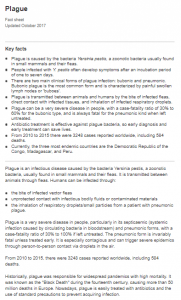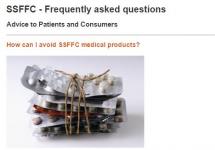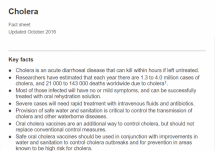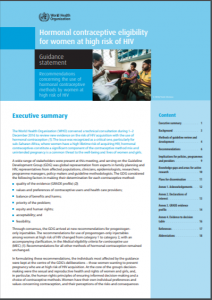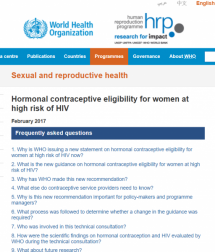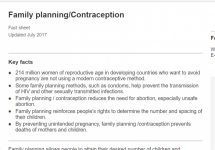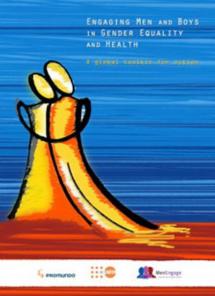Language: Russian
SSFFC – Frequently Asked Questions – Advice to Patients and Consumers
This website helps consumers with information about substandard, spurious, falsely labelled, falsified and counterfeit (SSFFC) medications:
- How can I spot an SSFFC medical product?
- How can I avoid SSFFC medical products?
- What should I do if I think I have an SSFFC medical product?
- Are SSFFC medical products available on the internet?
Source: World Health Organization
Date of Publication: March 25, 2019
SIMILIAR RESOURCES
Tools
Examples
- Frequently Asked Questions about Plague
- Substandard, Spurious, Falsely labelled, Falsified and Counterfeit (SSFFC) Medical Products
- Coronavirus disease (COVID-19) Advice for the Public
- Hormonal Contraceptive Eligibility for Women at High Risk of HIV- FAQs
- Zika Virus Disease: Questions and Answers
- Fact Sheet on Family Planning / Contraception
- Cholera Fact Sheet
- Coronavirus — COVID-19 Factsheet
- T3: Test. Treat. Track Initiative
- Malaria Evidence Base
Open WHO
OpenWHO is WHO’s interactive, web-based, knowledge-transfer platform offering online courses to improve the response to health emergencies. OpenWHO enables the Organization and its key partners to transfer life-saving knowledge to large numbers of frontline responders.
Last modified: March 25, 2019
Language: Chinese, English, French, Korean, Russian, Spanish
Hormonal Contraceptive Eligibility for Women at High Risk of HIV: Guidance Statement
The World Health Organization (WHO) convened a technical consultation during 1–2 December 2016 to review new evidence on the risk of HIV acquisition with the use of hormonal contraception. The issue was recognized as a critical one, particularly for sub-Saharan Africa, where women have a high lifetime risk of acquiring HIV, hormonal contraceptives constitute a significant component of the contraceptive method mix and unintended pregnancy is a common threat to the well-being and lives of women and girls.
The consultation developed recommendations, including:
- Women and couples at high risk of HIV infection continue to be eligible to use all forms of hormonal contraception. Informed decision-making is a key organizing principle and standard in a human rights-based approach to contraceptive information and services (5). A shared decision-making approach to contraceptive use should be taken with all individuals, but special attention should be paid to using this approach with vulnerable populations, such as women at high risk of acquiring HIV.
- Women should not be denied the use of progestogen-only injectables because of concerns about the possible increased risk. Women considering progestogen-only injectables should, however, be advised about this, about the uncertainty over a causal relationship, and about how to minimize their risk of acquiring HIV.
Last modified: March 25, 2019
Language: Arabic, English, French, Korean, Russian, Spanish
Hormonal Contraceptive Eligibility for Women at High Risk of HIV- FAQs
This is a list of frequently asked questions (FAQs) about how the World Health Organization developed its guidelines for hormonal contraception and women at high risk for HIV, as well as basic facts about this issue. Some of the questions are:
- Do hormonal contraceptives protect against HIV infection?
- Does using hormonal contraceptives increase the risk of contracting HIV?
- What is dual protection?
- What can be done to increase the ability of women and girls to practice dual protection?
- Can women living with HIV use hormonal contraceptives?
- Who should decide on what option is best for women and girls?
- Are the current options available for HIV prevention and contraception enough?
Last modified: March 25, 2019
Language: Arabic, English, French, Korean, Russian
Engaging Men and Boys in Gender Equality and Health Toolkit
Promundo and MenEngage Alliance with support from UNFPA produced this Toolkit that addresses strategies and lessons learned for Engaging Men and Boys in diverse themes such as Sexual and Reproductive Health; Maternal, Newborn and Child Health; Fatherhood; HIV and AIDS; Gender-based Violence; Advocacy and Policy, as well as addressing issues around Monitoring and Evaluation of this work.
It includes tools and activities from organizations and programs from around the world which can be adapted and utilized by other organizations. The toolkit includes information on: Introduction/Gender Transformative Programming, Sexual and Reproductive Health, Maternal, Newborn and Child Health, Fatherhood, HIV and AIDS, Gender-based Violence, Advocacy and Policy, and Monitoring and Evaluation.
Last modified: March 25, 2019
Language: English, French, Russian

